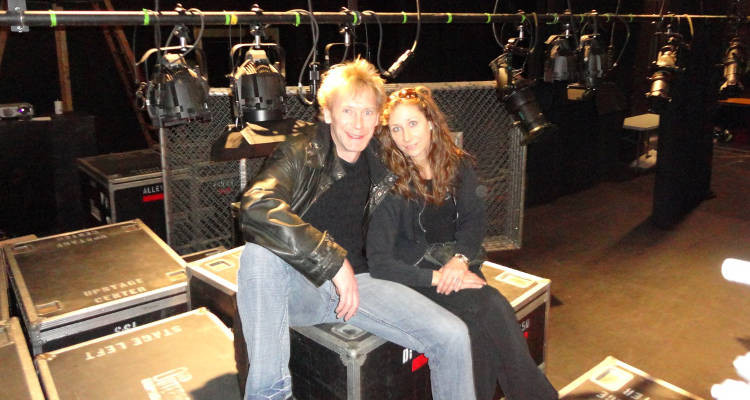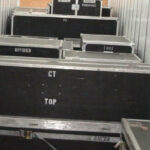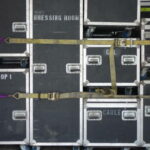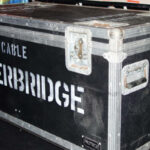We live out of about 50 road cases for a good portion of the year. It only makes sense that Ted should choose this topic for his latest article, “Road Case Ruminations”, in VANISH magazine. VANISH has grown to an audience of over 100,000 in over 45 countries around the world, and Ted is a regular contributor. The magazine averages over 150 pages per issue and, best of all, all issues published in the current year are FREE. You can read the article, reprinted with permission from VANISH magazine, here:
VANISH, Edition 18, pages 68-72
OUTERBRIDGE – Road Case Ruminations
By Ted Outerbridge
When I was 16 years old I somehow managed to line up a performance in a theatre in Bermuda! I was beyond excited, and even the nightmare of doing the paperwork required to fly my two doves to another country did not drag me down. I was determined to deliver a great performance and look like a pro. I decided it was time to transfer my cherished magic props from my grandmother’s old suitcase into something that offered more protection and a more professional look. I tracked down my friendly neighborhood road case manufacturer, and I can still remember the triumphant day when my first road case was delivered. I was delighted to have adjustable foam compartments to safely store all my props in, and I loved the way a road case created the illusion that I knew what I was doing when I arrived at a show.
A road case – or ATA case, flight case, transit case, or road box – is a shipping container specifically built to protect fragile equipment when it is transported between locations. When we perform our full illusion show, Outerbridge – Clockwork Mysteries, we have between 5,000 and 10,000 pounds of equipment that must be transported to and from a theatre, and we don’t want to arrive with broken props. Over the years I have purchased over 100 road cases and our current show travels in about 50. I have learned countless lessons over this time, through trial and error. For example, if a case weighs 200 pounds… casters (wheels) are a great idea. A glass milk pitcher should not travel in the same compartment as a loose heavy metal object. And if you don’t want anyone to flip a fog machine case on its side because it contains fog fluid that can spill and ruin the machine… you should stencil “NO FLIP” on the case!
When I first started buying custom-made road cases, I had them built for the size of my props. This worked well until I graduated from a minivan to a cube truck. At that point I found that I had a collection of randomly-sized cases, which made packing a truck rather challenging. I learned that a road case should be designed for both the prop and the truck, by using standard “Truck Pack” sizes. 1/4 pack, 1/3 pack and 1/2 pack are standard sizes.
Most cube trucks and straight trucks have an interior width of 90 inches, and 53-foot trailers tend to be 96 inches or wider. I try to design road cases for both 90″ and 96″ wide trucks by using a fraction of 90″ for one dimension and a fraction of 96″ for the other dimension. For example a 24″x45″ case can go in a 90″ wide straight truck (2×45″) or a 96″ wide trailer (4×24″). When I have small odd-sized road cases, I transport them in a larger truck pack sized case.
I also try to standardize the height of my road cases as much as possible, and I always order them with stacking “cups” or “dishes” in the lids. When they’re stacked, the casters of one case fit in the cups of the case it’s on top of, so the upper one doesn’t roll around. When possible, I use a height of either 26″ or 38″ (including the casters) so I can stack the cases two or three high and end up with a uniform height of 76″.
Here are some common Truck Pack sizes:
22.5″x32″
22.5″x48″
24″x30″
24″x45″
30″x32″
30″x48″
32″x45″ (will not fit through all doors)
Road cases are made of laminate panels. The panel has an outer layer of ABS or fiberglass laminate which is glued to 1/4″, 3/16″ or 1/2″ plywood. I strongly recommend using 1/2″ panels unless you are sure you will always handle your cases yourself. When road cases are moved on and off of airplanes, ships and trucks, sometimes with forklift trucks, they are often abused so they should be heavy duty!
Road cases can come in just about any color you can imagine. Since they are often visible in the wings, black is a popular choice for touring shows. Black is my preference, although Marion would like a pink wardrobe case for her 21 costumes!
I always use recessed hardware when it is an option, because surface-mounted catches and handles tend to shear off when they come into contact with other road cases or the sides of a truck. Large latches are easier to open than smaller ones and they are more solid. If a case can’t comfortably be lifted by one person, casters are essential. 4-inch casters make life a lot easier compared to smaller, cheaper casters. The casters should be spaced so they fit on a standard-size truck loading ramp, otherwise they’ll have to go on the ramp diagonally which is not fun. These choices cost a bit more but they are well worth it. A road case has a very long lifespan, and cheap hardware results in a lot more repairs.
I am happy to report that the four large brandy snifters we use for the Himber Ring and Snowstorm have never broken during transport, thanks to their individual foam compartments in our Prop case. There are many options for lining the interior of a road case, depending on what is being transported. Ether foam is for heavy shock absorption and it works well under heavy items. Ester foam is good for softer, yet firm, cushioning to protect fragile items. Sometimes carpeting or Ozite is all that’s required. It is important to keep the foam thickness in mind when you’re designing a road case.
I have a labeling fetish. I use numerous labeling devices to label almost everything in sight. This comes in handy on tour, when many different people are involved during the setup and strike of our show. I labeled the Airborne Glass bottle so everyone knows how much water to put in it. I label our flashlights and cables so they aren’t confused with the ones belonging to the local theatre. I label the drawers of our Prop case so everyone knows what is where. And finally, I label road cases. Years ago I acquired a brass stencil kit for spray-painting letters, and I don’t know what I’d do without it. I use it to label the interior compartments of road cases to help people pack equipment in the correct spot. I also label the exterior of road cases with our name and the contents of the case, for example PROP or TIME MACHINE. As well, I label the destination for the road case when it arrives at a theatre. For example our Wardrobe case is labeled DRESSING ROOM and our Prop case is labeled STAGE LEFT. This allows the local crew to unload our truck and deliver all our equipment to the right locations. I label the four sides and the top of each road case, so we can identify them when they are stacked and when they are placed against a wall or a curtain, or next to each other.
After a performance, it takes about 90 minutes to pack all our equipment back into its road cases. Once this is done, it’s time for the Load-Out. We use a Truck Pack diagram that shows where each case will go in the truck, and we tape it to the wall just inside the truck. We’ve also used a series of photos to show the order in which the truck is packed. Often we are using every available cubic foot of the truck to fit our show, and these visual instructions help to eliminate packing nightmares. They also ensure that we don’t forget anything at the theatre.
A member of our team “calls the pack” by announcing which case goes on the truck next. The local crew rolls each case onto the truck as they are instructed, and stacks them when necessary. This procedure allows us to get the truck loaded quickly, which is important because everyone on our team has had a long day. When we are really organized, we number the cases in the order they are loaded, which make the job run even more smoothly.
We use load bars and ratchet straps to secure our road cases and prevent shifting in the truck. They are secured in sections about eight feet deep. We always use two straps for each section, especially the last section. The momentum of a moving truck can be incredibly powerful, so securing the load prevents our show from ending up on the highway!






